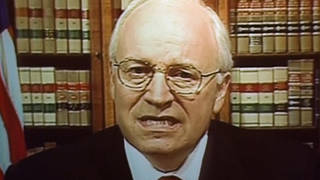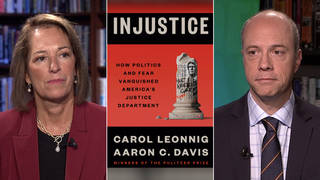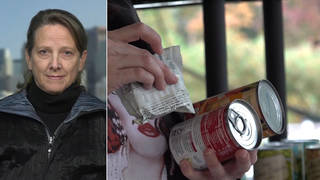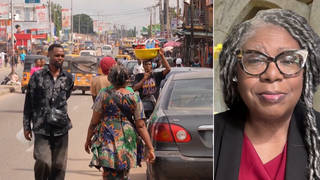
Topics
Guests
- Satsuki InaJapanese-American psychotherapist born in the Tule Lake Segregation Center, a maximum-security concentration camp for Japanese Americans during WWII.
We speak with Japanese-American psychotherapist Satsuki Ina, a survivor of World War II internment who is now a leading activist against the jailing of migrant and refugee children on the border. Ina was among a group of Japanese-American elders that protested outside the Fort Sill Army post in Oklahoma, where the Trump administration plans to indefinitely detain 1,400 immigrant and refugee children starting next month. Fort Sill was an internment camp for 700 Japanese-American men in 1942. Ina says, “The term 'concentration camp' is a way of describing the reality of what was done to us, and not using the language that the government imposed, distorting the reality of what happened to us.”
Transcript
AMY GOODMAN: This is Democracy Now!, democracynow.org, The War and Peace Report. I’m Amy Goodman, with Juan González.
JUAN GONZÁLEZ: We continue to look at the traumatic impact on the mental health of migrant children from being held by the Border Patrol and Immigration and Customs Enforcement detention centers. In Oakland, we’re joined by Satsuki Ina, who was born in the Tule Lake segregation center, a maximum-security internment camp for Japanese Americans during World War II.
AMY GOODMAN: Satsuki Ina runs a psychotherapy practice in the San Francisco Bay Area now. She’s been researching the long-term impact of incarceration trauma and its intergenerational impact. She was the producer and co-director of the documentary Children of the Camps. This past weekend, she risked arrest at a protest against the plan to detain migrant children at Fort Sill, Oklahoma, the site of a former Japanese-American internment camp.
We want to go to a clip of your film, Children of the Camps. You were co-director of that film. Let’s turn to a clip that features you and your family story.
SATSUKI INA: We all had different ways of dealing with the trauma. And many of those decisions that we made were under tremendous duress and under the most bizarre of circumstances, rumors abounding, not knowing what are the limits of this imprisonment. So, people made choices that they had to live with the consequences of for many, many years, even today.
NARRATOR: Dr. Ina’s family was separated shortly after her birth, her father taken away in the middle of the night, her mother left alone with two babies behind barbed wire.
SATSUKI INA: She wrote in her diary shortly after my father was taken. She said, “I wonder if today’s the day that they’re going to line us up and shoot us.”
NARRATOR: Months later, word came that her father was in a prisoner of war camp in North Dakota. Two years would pass before the family would be reunited.
SATSUKI INA: This whole idea of being innocent, but being viewed as the enemy, being viewed as a risk to national security, was very difficult to make sense out of. I think, for the most part, most Japanese Americans who are my age will tell you that their parents never talked to them about the internment experience. Too painful, too shameful, too much a part of the past that never made sense even to them.
AMY GOODMAN: Satsuki Ina, that’s a clip from the film you made, Children of the Camps. But I wanted to ask you just if you could briefly tell us your history, what Tule Lake was, where you were born, how long you were held there, the conditions of this camp, and just the overall description of what happened to Japanese Americans during World War II. I think very few people outside the Japanese-American community understand that well over 100,000 Japanese and Japanese Americans were imprisoned during World War II.
SATSUKI INA: My parents were newly married and living in San Francisco. They were forcefully removed from their homes as a result of the Executive Order 9066, that eventually led to 120,000 people of Japanese ancestry to be imprisoned, for some people up to five years. My parents were held for four-and-a-half years.
They answered a loyalty question that was imposed on them after they were incarcerated, a questionnaire that asked them to state their loyalty to the U.S. And my parents, by then, were very despairing of their—of the future, possibilities of a good life for their children in America. So they eventually renounced their American citizenship, thinking that if they went to Japan—although they were American citizens, born in San Francisco and Seattle, they had given up hope on America.
And so, there were 10 War Relocation Authority prison camps and multiple others, other prison camps, run by the Department of Justice. My father would eventually be separated from us and sent to Bismarck, North Dakota.
The conditions at Tule Lake segregation center were more dire than in the other prison camps. There was a quality of—the treatment of people considered disloyal was more severe. So my mother wrote in her diary that there wasn’t enough coal to heat the barracks that they lived in, that there wasn’t enough milk for the children. She was worried constantly and lived in a state of fear during her entire time of being incarcerated.
And I think mass incarceration of our community has led to mass mental health issues, that outwardly aren’t very apparent because, generally, our coping mechanism has been to be compliant and nonconfrontational, to, you know, defer and quietly stay under the radar. And in that way, we’ve been called the model minority, which is, in fact, I think, a reflection of the degree to which we have suffered the long-term consequences of trauma.
JUAN GONZÁLEZ: I wanted to ask you, when you hear the debate now about U.S. Representative Alexandria Ocasio-Cortez calling the migrant camps “concentration camps,” and others in an uproar that this somehow belittles the Holocaust in Europe by using that term, but when you’re dealing with places like Fort Sill, which not only interned Japanese Americans but was also used, before that, to intern the Apaches, Geronimo and other Apaches, who were herded into Fort Sill, as well, your take on this debate over the issue of whether “concentration camps” should be used?
SATSUKI INA: Well, you know, So much euphemistic language was used to cover up and minimize the impact of what they were doing to us in 1942, so language like “relocation centers” and “evacuation,” instead of “arrest” and “imprisonment.” So, to call them “relocation centers,” when they were in fact concentration camps—the definition of “concentration camps” has to do with the imprisonment, mass incarceration of innocent people for political reasons. And so, the term “concentration camp” is a way of describing the reality of what was done to us, and not using the language that the government imposed, distorting the reality of what happened to us.
So, I can understand that people will want to make comparisons, but it’s not about comparing. It’s about speaking the truth. We were deprived of our freedom, and we suffered the consequences of being incarcerated without—under indefinite detention without any due process of law. And the term “concentration camp” is much more the reality of what happened to us.
AMY GOODMAN: When your father was taken away from you inside the camp, inside Tule Lake, and your mother left with her two children, you one of them, talk about that and when you learned that he was being held at another camp, in North Dakota, another concentration camp, as you put it.
SATSUKI INA: So, my father was taken and put inside the jail within the jail that was built inside of Tule Lake, and then, from there, removed. And we didn’t know where he was for a period of time. And, you know, they were allowed to correspond, but there was extreme censorship. So the letters that I found that my parents had written to each other had these big cuts, razor cuts. And the confusion and the misunderstanding of what was happening was a result of that continued censorship. It was just an example of the kind of torturous life that they led, not knowing where he was, not knowing exactly what was happening.
And this was, you know, a form of trauma that continued to be experienced in my family even afterwards. My father, when we were reunited, was a complete stranger to me. And I was fearful of him, because I had been, from birth, from in utero, been with a mother who lived in fear every day of her life. And when he came back into our life, I had no idea who he was.
And I’ve continued that level of anxiety for most of my life, until I began this healing journey, which I think manifested in the need to stand up and defend and speak out for these children, particularly these children held under very similar circumstances. Fort Sill is a place where 700 men of Japanese ancestry were held under indefinite detention. And so, it’s not known that we suffered family separation, but it was one of the most traumatic elements of our experience.
JUAN GONZÁLEZ: And as a psychotherapist, your sense of what the long-term damage is or could be to so many of these children now that are being held in these detention centers and these jails all along the border in the United States, and even in the interior of the country?
SATSUKI INA: Well, you know, current neuroscience shows that chronic states of trauma actually alters the physiology of the nervous system. And so, a child who is living in fear every day, and even in the arms of a mother who is fearful every day, sets the stage for the child to be anxious, depressed, and carry this throughout their childhood. And so, what we’re doing today to these children that are being confined in these terrible circumstances is creating mass mental health issues that are going to take a lifetime to heal. And as a person who has experienced that personally, as a professional who has seen that in patients who have suffered from the Japanese-American incarceration experience, I think it’s an atrocity, what is happening to these children today.
AMY GOODMAN: In this clip from your documentary, Children of the Camps, we hear from Bessie Masuda, who was interned in Rohwer, Arkansas, at the age of 12. Some 50 years after she was separated from her father, Masuda retrieved a letter she wrote to the president of the United States as a child, appealing to the president to release her father and reunite her family.
BESSIE MASUDA: February 15th, 1944. Dear Sir, We want to know when our father may come back to us. It has been so long since he was away. Our father was taken on the night of Washington’s birthday, and that was February 22nd, 1942. Oh, please, will you release him and have him join us? We’ve been praying that he would come back to us soon, and we hope that will be true. I am writing this letter for the sake of my mother. She always worries a lot, and I don’t want her to worry, because she has been ill so many times. I am asking you again to please release my father. He hasn’t done any harm to this country.
AMY GOODMAN: And this is Howard Ikemoto, who was interned at the age of 2 in Tule Lake, California, like you were, Satsuki, speaking about his quest to understand what had happened to him as a child.
HOWARD IKEMOTO: I was abandoned, and I needed to know the reason why. I mean, I wanted to know. And this had been a quest. Why was I thrown away?
SATSUKI INA: So, who abandoned you, Howard?
HOWARD IKEMOTO: My country. My country. You know, this is my country. And now this is my home, and nobody’s going to tell me any different.
AMY GOODMAN: And in this clip from Children of the Camps, we hear from Japanese American Toru Saito, who was interned at the age of 4 in Topaz, Utah.
TORU SAITO: My mother shouldn’t have been put through this crap, you know? She went through hell. And I remember that hell through my mother’s eyes and from her inability to explain or to understand. So, it was—I think it magnified things for me. You know, when you see your mother suffering, you suffer.
AMY GOODMAN: So, with all of that, Satsuki Ina, and all that you have documented in the community, making this film, Children of the Camps, and your own experience at Tule Lake, your father’s experience in North Dakota, you then go to Oklahoma this past weekend. And you’re holding this news conference at Fort Sill, where something like 1,400 migrant children are expected to be sent, and you’re told that you could be arrested if you hold this news conference. You’re there with four other Japanese-American elders to speak out against their incarceration. Talk about the decision you made at that point, because you say for so many years you were obedient, to be willing to risk arrest to hold that news conference, when the MP came out and told you to get out of there.
SATSUKI INA: They’re wanting to remove us. We’ve been removed too many times. If that’s what it comes to—
MILITARY POLICE OFFICER KEYES: What don’t you people understand?
SATSUKI INA: —we will stay here and—
MILITARY POLICE OFFICER KEYES: What don’t you people understand?
UNIDENTIFIED: We understand the whole history of this country, and we aren’t going to let it happen again. What were you saying, Satsuki?
SATSUKI INA: That we want to make a stand. We want to say that we are protesting the fact that 1,400 children are going to be brought to this military site. We’re here because we do not want to have that happen. And as former children of prison camps, of concentration camps in America, we are saying, “No more. Never again.”
SATSUKI INA: There were actually six of us former incarcerees—they called us “elders”—who had been children in prison during World War II. And we knew that there was a possibility that we would be arrested for resisting our removal. And I think we all decided, clearly, that we didn’t want to be removed again and that we would stand our ground and make sure that we completed what we intended to do, which was to tell our story to the press and to the American public.
And it was a powerful moment for us to be confronted once again by, you know, a military police officer, raising his voice, demanding that we leave immediately, asking if we understood English. And we took our deep breaths and calmly recognized that if that was what was going to happen, we were willing to do that, that taking a stand for these children today was something we had hoped for that would have happened for us when we were incarcerated. And so we were determined. And we were successful in resisting his demand that we leave until we finished what we had come for.
AMY GOODMAN: Satsuki Ina, we want to thank you for being with us, born in Tule Lake, the camp, the detention camp, what she calls the concentration camp, the maximum-security camp for Japanese Americans during World War II. She co-directed the documentary Children of the Camps, is a psychotherapist who helps those who deal with these kind of childhood traumas.
To see Part 1 of Satsuki Ina’s protests in Oklahoma, as well as our discussions about the incarceration of children, go to democracynow.org. I’m Amy Goodman, with Juan González. Thanks so much for joining us.











Media Options